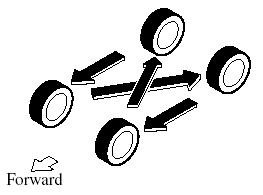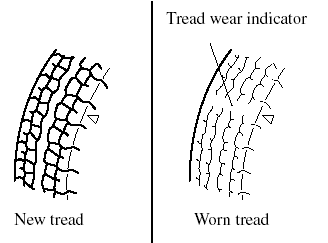Tire Maintenance
Improper or inadequate vehicle maintenance can cause tires to wear
abnormally. Here are
some important maintenance points:
Tire Inflation Pressure
Inspect all tire pressure monthly (including the spare) when the tires are
cold. Maintain
recommended pressures for the best ride, top handling, and minimum tire wear.
Use the
pressures specified on the vehicle tire information placard or tire label for
optimum service.
Tire Rotation
To equalize tread wear, rotate the tires every 12,000 km (7,500 miles) or
sooner if irregular
wear develops. During rotation, inspect them for correct balance.

Do not include (TEMPORARY USE ONLY).
spare tire in rotation.
Inspect the tires for uneven wear and damage. Abnormal wear is usually caused
by one or a
combination of the following:
- Incorrect tire pressure
- Improper wheel alignment
- Out-of-balance wheel
- Severe braking
After rotation, inflate all tire pressures to specification and
inspect the lug nuts
for tightness.
CAUTION:
Rotate unidirectional tires and radial tires that have an asymmetrical tread
pattern
or studs only from front to rear, not from side to side. Tire performance will
be
weakened if rotated from side to side.
(With limited-slip differential).
Don't use the following:
 Tires not of the designated size
Tires not of the designated size
 Tires of different sizes or types at the same time
Tires of different sizes or types at the same time
 Tires not sufficiently inflated
Tires not sufficiently inflated
If these instructions aren't followed, the rotation of the left and right wheels
will be
different and will thus apply a constant load on the limited-slip differential.
This will cause a malfunction.
Replacing a Tire
WARNING:
Always use tires that are in good condition:
Driving with worn tires is dangerous. Reduced braking, steering, and traction
could
result in an accident.

If a tire wears evenly, a wear indicator will appear as a solid band across
the tread. Replace
the tire when this happens.
You should replace it before the band is across the entire tread.
NOTE:
Tires degrade over time, even when they are not being used on the road. It is
recommended that tires
generally be replaced when they are 6 years or older. Heat caused by hot
climates or frequent high
loading conditions can accelerate the aging process. Regarding the manufacturing
week and year is
indicated with 4 digit. Refer to The tire labeling.
Safety Practices
The way you drive has a great deal to do with your tire mileage and safety.
So cultivate
good driving habits for your own benefit.
- Observe posted speed limits - Avoid fast starts, stops and turns - Avoid potholes and objects on the road - Do no run over curbs or hit the tire against the curb when parking
CAUTION:
If you feel a sudden vibration or ride disturbance while driving or you suspect
your
tire or vehicle has been damaged, immediately reduce your speed. Drive with
caution
until you can safely pull off the road. Stop and inspect the tire for damage. If
the tire
is under-inflated or damaged, deflate it, remove the tire and rim and replace it
with
your spare tire. If you cannot detect a cause, have the vehicle towed to the
nearest
vehicle or tire dealer to have the vehicle inspected.
See also:
The Inside
Here's where the Mazda5's small size catches up with it. When compared to
larger minivans, there's just not a lot of extra space behind the front bucket
seats. The Mazda5 does, however, make effic ...
Exterior Design
New fog lamps bezels are introduced that are more pointed and lowing. These
bezels frame an "inner eye" made up of a round fog lamp inside a lowing lower
lid for a strong sense of refine ...
Center-Rear Position Seat Belt (3-Point Type)
Before using the center-rear lap/shoulder
belt make sure tongue (A) and anchor
buckle (B) are fastened.
Fastening the Seat Belt
1. Grasp the tongue (C).
2. Slowly pull out the lap/shoulder be ...


